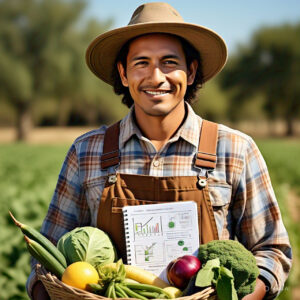Bridging the gap between farms, markets, and sustainable futures.
1. Why Agricultural Economics Matters
Agricultural economics applies micro- and macro-economic tools to the production, distribution, and consumption of food and fiber. Because agriculture sits at the nexus of land, water, labor, and energy, its economics directly influence:
| Area | Key Questions Agricultural Economists Ask |
|---|---|
| Food Security | How can we guarantee affordable, nutritious food for all? |
| Climate Policy | Which farm practices cut emissions without harming yields? |
| Rural Livelihoods | What policies raise farm incomes and spur local growth? |
2. Four Pillars Linking Ag-Econ to Food Security
| Pillar | Economic Lens | Real-World Example |
|---|---|---|
| Production & Productivity | Cost curves, technology adoption models | Subsidizing drought-tolerant seed improves yields in Ethiopia. |
| Market Access & Prices | Supply–demand, spatial market integration | Upgrading rural roads in Vietnam cut travel time, raised farm-gate rice prices, and lifted smallholders out of poverty. |
| Stability & Risk Management | Futures markets, crop-insurance design | Index-based insurance in Kenya cushions pastoralists during droughts. |
| Utilization & Nutrition | Household demand systems, income elasticities | Cash-plus-nutrition programs in Bangladesh shift diets toward protein-rich foods. |
When any pillar weakens (e.g., price spikes or crop failures), food insecurity rises. Agricultural economists quantify these linkages, helping governments decide whether to release grain reserves, adjust import tariffs, or expand safety-net transfers.
3. Agricultural Economics & Climate Policy: A Two-Way Street
-
Agriculture → Climate: Farming emits ~23 % of global GHGs (enteric methane, nitrous oxide from fertilizers, deforestation).
-
Climate → Agriculture: Heat stress, erratic rainfall, and extreme events trim yields and raise volatility.
Economists use partial- and general-equilibrium models to simulate how carbon taxes, subsidies, or regulations ripple through agri-food systems.
| Climate-Smart Policy | Economic Question | Insight |
|---|---|---|
| Carbon Pricing | Will a carbon price raise food costs? | Modest carbon fees (< $25 t-CO₂e) lift retail grain prices < 3 % if paired with efficiency gains. |
| Subsidizing Conservation Agriculture | What is the break-even adoption cost? | Zero-tillage pays off after 2–3 years through fuel savings and higher soil moisture. |
| Methane-Reducing Feed Additives | Who bears the cost—producers or consumers? | Cost-sharing schemes keep beef affordable while rewarding low-emission ranchers. |
4. Case Study: Pakistan’s Wheat Market under Climate Stress
-
Challenge: Rising temperatures reduce wheat yields by ~0.9 % per °C.
-
Economic Insight: A crop-growth–price-transmission model predicts a 6 % production shortfall by 2030, potentially doubling import bills.
-
Policy Options:
-
Invest in heat-tolerant varieties (benefit–cost ratio ≈ 4:1).
-
Expand strategic grain reserves to stabilize prices.
-
Introduce weather-index insurance to protect smallholders.
-
Economists rank these options by net present value and distributional impact, guiding budget allocations.
5. Tools of the Trade
| Tool | Purpose |
|---|---|
| Computable General Equilibrium (CGE) Models | Evaluate economy-wide effects of climate policies. |
| Stochastic Frontier Analysis | Measure technical efficiency under resource constraints. |
| Life-Cycle Costing | Compare long-term costs of low-carbon technologies (e.g., solar pumps vs. diesel). |
| GIS-Based Market Access Indices | Identify infrastructure bottlenecks hindering food flows. |
6. Policy Recommendations
-
Price Signals with Protection: Use carbon pricing or fertilizer levies but recycle revenues into targeted food vouchers for vulnerable consumers.
-
Invest in R&D: Public funding for climate-resilient crops yields high social returns (~35 % per year).
-
Scale Risk-Transfer Instruments: Weather insurance and warehouse receipts stabilize farm incomes, lowering default risk for lenders.
-
Support Inclusive Value Chains: Encourage contract farming and digital platforms to shorten supply chains and reduce post-harvest losses.
-
Mainstream Nutrition Goals: Align farm subsidies with dietary guidelines (e.g., pulses, fruits, vegetables) to tackle hidden hunger.
7. Key Takeaways
-
Interlinked Goals: Food security and climate mitigation are inseparable; policies must tackle both simultaneously.
-
Economic Evidence Matters: Rigorous ag-econ analysis prevents well-meaning interventions from backfiring.
-
Future Outlook: With smart incentives and innovations, agriculture can feed 9 billion people by 2050 while meeting emission targets.
Further Reading & Resources
-
FAO. The State of Food Security and Nutrition in the World (annual).
-
IPCC. Climate Change and Land (2019).
-
Norton, Alwang & Masters. Economics of Agricultural Development (Routledge).
-
Rice in Pakistan: Historical Trends in Area, Productivity, and Output (1947–2024
-
Understanding Inflation in Pakistan: Causes, Trends, and Impact on Daily Life



